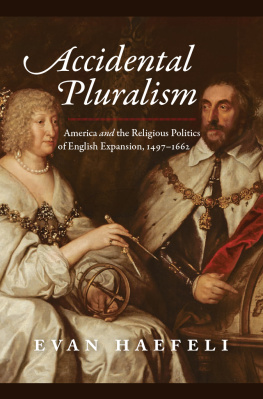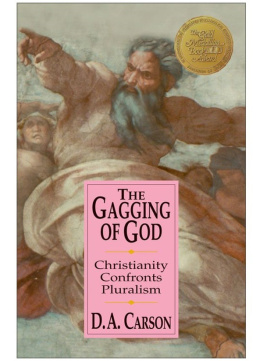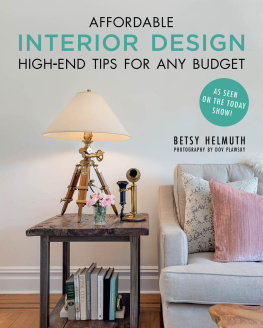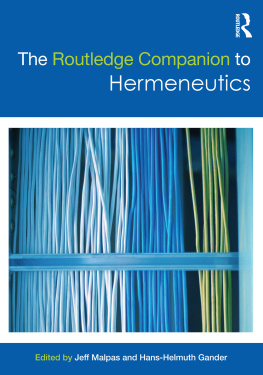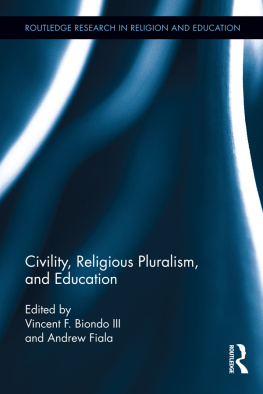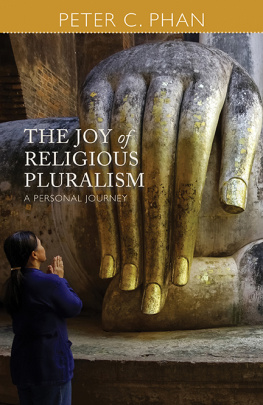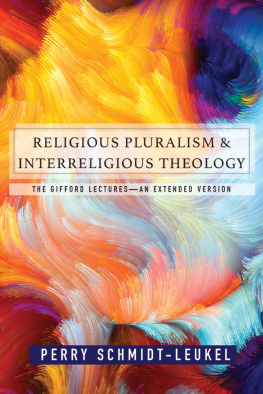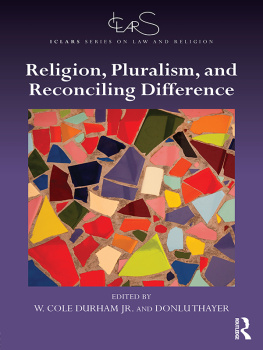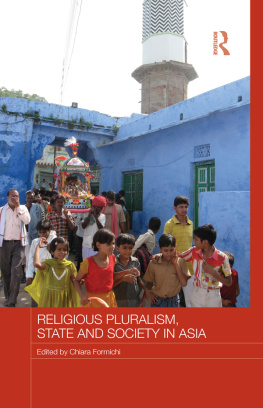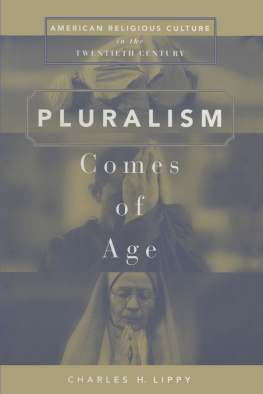Helmuth Berking - Religious Pluralism and the City
Here you can read online Helmuth Berking - Religious Pluralism and the City full text of the book (entire story) in english for free. Download pdf and epub, get meaning, cover and reviews about this ebook. year: 2018, publisher: Bloomsbury UK, genre: Religion. Description of the work, (preface) as well as reviews are available. Best literature library LitArk.com created for fans of good reading and offers a wide selection of genres:
Romance novel
Science fiction
Adventure
Detective
Science
History
Home and family
Prose
Art
Politics
Computer
Non-fiction
Religion
Business
Children
Humor
Choose a favorite category and find really read worthwhile books. Enjoy immersion in the world of imagination, feel the emotions of the characters or learn something new for yourself, make an fascinating discovery.
- Book:Religious Pluralism and the City
- Author:
- Publisher:Bloomsbury UK
- Genre:
- Year:2018
- Rating:5 / 5
- Favourites:Add to favourites
- Your mark:
- 100
- 1
- 2
- 3
- 4
- 5
Religious Pluralism and the City: summary, description and annotation
We offer to read an annotation, description, summary or preface (depends on what the author of the book "Religious Pluralism and the City" wrote himself). If you haven't found the necessary information about the book — write in the comments, we will try to find it.
Religious Pluralism and the City — read online for free the complete book (whole text) full work
Below is the text of the book, divided by pages. System saving the place of the last page read, allows you to conveniently read the book "Religious Pluralism and the City" online for free, without having to search again every time where you left off. Put a bookmark, and you can go to the page where you finished reading at any time.
Font size:
Interval:
Bookmark:

To Peter L. Berger, who was not just a mentor but a friend.
Bloomsbury Studies in Religion, Space and Place
Series editors: Paul-Franois Tremlett, John Eade, and Katy Soar
Religions, spiritualities and mysticisms are deeply implicated in processes of place-making. These include political and geopolitical spaces, local and national spaces, urban spaces, global and virtual spaces, contested spaces, spaces of performance, spaces of memory and spaces of confinement.
At the leading edge of theoretical, methodological, and interdisciplinary innovation in the study of religion, Bloomsbury Studies in Religion, Space and Place brings together and gives shape to the study of such processes. These places are not defined simply by the material or the physical but also by the sensual and the psychological, by the ways in which spaces are gendered, classified, stratified, moved through, seen, touched, heard, interpreted and occupied. Places are constituted through embodied practices that direct critical and analytical attention to the production of insides, outsides, bodies, landscapes, cities, sovereignties, publics and interiorities.
Religion and the Global City, edited by David Garbin and Anna Strhan

Front of the kumenisches Forum HafenCity (Photo courtesy Veronika Eufinger)
Vista of the chapels anteroom at night (Photo courtesy Veronika Eufinger)
Russell Market (left) and St. Marys Basilica (right) (Photos courtesy Tulasi Srinivas)
Hawkers in the Square (Photos courtesy Tulasi Srinivas)
Temple in the street leading to the Square (Photo courtesy Tulasi Srinivas)
Businesses that front the Square (Photo courtesy Tulasi Srinivas)
Before 2008 election graffiti (left 2008; right 2016) (Photos courtesy Tovi Fenster)
Modesty signs in Mea Shearim neighborhood (left 2002; right 2016) (Photos courtesy Tovi Fenster)
Graffiti on the caf wall (left 2008; right 2016) (Photos courtesy Tovi Fenster)
New shops and maintenance in Mea Shearim main road (2016) (Photos courtesy Tovi Fenster)
Neo-liberal housing in ultra-Orthodox neighborhood (2016) (Photos courtesy Tovi Fenster)
Major cities of ancient Mesopotamia (not all contemporaneous) (Graphic courtesy Eva Cancik-Kirschbaum)
Developmental stages of the cuneiform script (Graphic courtesy Eva Cancik-Kirschbaum. Representation based on A. Wolf on the basis of Nissen 1990: Fig. 20)
The sacred precinct in the center of Uruk (Graphic courtesy Eva Cancik-Kirschbaum. Representation based on A. Wolf on the basis of Yoffee 2005/9: 84)
)
NINo registrations by gender, 20022014
NINo registrations by region (% in each) in selected years
Nezar AlSayyad is Professor of Architecture, Planning, Urban Design and Urban History at the University of Berkeley.
Christopher Baker is William Temple Professor of Religion and Public Life at Goldsmiths, University of London and Director of Research, William Temple Foundation.
Irene Becci is Assistant Professor at the Faculty of Theology and Religious Studies, University of Lausanne.
Peter L. Berger was Professor Emeritus for Sociology and Theology at Boston University.
Helmuth Berking is Permanent Fellow at the Technische Universitt Berlin.
Marian Burchardt is Postdoctoral Researcher at the Humanities Centre for Advanced Studies Multiple SecularitiesBeyond the West, Beyond Modernities, Leipzig University.
Eva Cancik-Kirschbaum is Professor of Ancient Near Eastern Philology and History at the Freie Universitt Berlin.
John Eade is Professor of Sociology and Anthropology at the University of Roehampton and former Director of CRONEM (Centre for Research on Nationalism, Ethnicity and Multiculturalism).
Veronika Eufinger is Doctoral Researcher at the Center for Religious Studies, Ruhr-Universitt Bochum.
Tovi Fenster is Professor in the Department of Geography and Human Environment at Tel Aviv University and Head of the Planning for the Environment with Communities (PEC) Lab.
Mariachiara Giorda is Researcher at the Department of Historical Studies, University of Turin.
Stephan Lanz is Senior Lecturer in the Faculty of Social and Cultural Sciences, Europa-Universitt Viadrina, Frankfurt (Oder).
Martijn Oosterbaan is Associate Professor at the Department of Cultural Anthropology, Utrecht University.
Jochen Schwenk is Postdoctoral Researcher at the Institute for Sociology, Technische Universitt Darmstadt.
Tulasi Srinivas is Associate Professor of Anthropology at Emerson College, Boston.
Silke Steets is Heisenberg Fellow at the Faculty of Social Sciences and Philosophy, Leipzig University.
The idea for this book arose from a conference titled Filling the Void?Religious Pluralism and the City, conducted by the three editors at the Technische Universitt Darmstadt in February of 2016. We wish to thank Heike Kollross, Allegra Baumann, and Aaron Szczerba for their support in planning and organizing the event. We are also indebted to the authors of this book for their commitment, their expertise and the highly productive and insightful exchanges. Lalle Pursglove and Lucy Carroll at Bloomsbury Academic assisted us in the production of the book by providing valuable advice and practical suggestions; Marie Veltmaat prepared the index and was invaluable in the copyediting process; Matthew Harris translated and copyedited parts of the Introduction. We also owe our thanks to the anonymous reviewers for their constructive criticism of the book concept, and hope that we have implemented their suggestions the way they intended us to. Our deepest gratitude goes to Peter L. Berger. It was his persistent reflection on pluralism, modernity, and religion which inspired us to make the relationship between the city and religious pluralism the subject of a conference and later the topic for this book. During the planning phase of the conference, Peter was there with constructive and targeted comments as well as a sympathetic ear. Although he was unable to travel to Darmstadt for the conference, he willingly accepted the challenges of digital technology and gave his keynote address via Skype. Unfortunately, he does not see the book completed. He died on June 27, 2017. This volume is dedicated to him.
Helmuth Berking, Jochen Schwenk, Silke Steets
Given the rise of religiously inspired violence and the increasing significance of Charismatic Christianity, Islam, and other spiritual traditions, the master narrativeonce taken for grantedthat modernizing societies are simultaneously secularizing societies has long since lost its empirical plausibility. As scholars of religion have shown, it is not so much the decline but rather the pluralization of religion, that is, the simultaneity of secular and religious institutions (pluralism 1) and the coexistence of different religious worldviews (pluralism 2) in one space that shape everyday life in todays world (Berger 2014). The main thesis of this book is that the particular constellation of these two pluralisms plays out above all in cities. It is the city where power struggles and conflicts concerning the right to religious practices and representations in the public realm are carried out, where new civilizational arrangements are made or opportunities to are squandered. However, discussion of religious pluralism as a defining feature of the city has long been falling on deaf ears in urban theory, as well as in religious studies (Burchardt and Becci 2013; Garbin and Strhan 2017). In what follows, we will, firstly, reconstruct how this conceptual void between city and religion emerged, and then try to fill this void conceptually as well as empirically. The overall aim of this volume is to unveil the intimate relationship between city and religion, and to offer an alternative view regarding the quotidian state of the global urban condition. But how can the long-lasting ignorance of urban theory about religion and the sociology of religion about the city be explained? As is shown in the following, there is a single answer to this twofold question: The theoretical traditions of both disciplines have developed their central concepts within the context of a modernizing society (and a modernization theory-based narrative), which shapes sociological theory building in general and leads to a situation where, for both strands, the modern metropolis remains the secular space per se. But what would ways out of the lost subset between the city and religion look like?
Next pageFont size:
Interval:
Bookmark:
Similar books «Religious Pluralism and the City»
Look at similar books to Religious Pluralism and the City. We have selected literature similar in name and meaning in the hope of providing readers with more options to find new, interesting, not yet read works.
Discussion, reviews of the book Religious Pluralism and the City and just readers' own opinions. Leave your comments, write what you think about the work, its meaning or the main characters. Specify what exactly you liked and what you didn't like, and why you think so.



